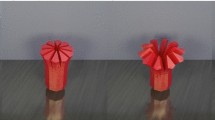Abstract
Surgical simulators need to simulate deformation and cutting of deformable objects. Adaptive octree mesh based cutting methods embed the deformable objects into octree meshes that are recursively refined near the cutting tool trajectory. Deformation is only applied to the octree meshes; thus the deformation instability problem caused by degenerated elements is avoided. Biological tissues and organs usually contain complex internal structures that are ignored by previous work. In this paper the deformable objects are modeled as voxels connected by links and embedded inside adaptive octree meshes. Links swept by the cutting tool are disconnected and object surface meshes are reconstructed from disconnected links. Two novel methods for embedding triangular meshes as internal structures are proposed. The surface mesh embedding method is applicable to arbitrary triangular meshes, but these meshes have no physical properties. The material sub-region embedding method associates the interiors enclosed by the triangular meshes with physical properties, but requires that these meshes are watertight, and have no self-intersections, and their smallest features are larger than a voxel. Some local features are constructed in a pre-calculation stage to increase simulation performance. Simulation tests show that our methods can cut embedded structures in a way consistent with the cutting of the deformable objects. Cut fragments can also deform correctly along with the deformable objects.
Similar content being viewed by others
References
Ruthenbeck G S, Reynolds K J. Virtual reality for medical training: The state-of-the-art. Journal of Simulation, 2015, 9(1): 16-26.
Bric J D, Lumbard D C, Frelich M J, Gould J C. Current state of virtual reality simulation in robotic surgery training: A review. Surgical Endoscopy, 2016, 30(6): 2169-2178.
Wu J, Westermann R, Dick C. A survey of physically based simulation of cuts in deformable bodies. Computer Graphics Forum, 2015, 34(6): 161-187.
Mor A B, Kanade T. Modifying soft tissue models: Progressive cutting with minimal new element creation. In Proc. the 3rd International Conference on Medical Image Computing and Computer-Assisted Intervention, October 2000, pp.598-607.
Bielser D, Glardon P, Teschner M, Gross M. A state machine for real-time cutting of tetrahedral meshes. Graphical Models, 2004, 66(6): 398-417.
Metzger M C, Gissler M, Asal M, Teschner M. Simultaneous cutting of coupled tetrahedral and triangulated meshes and its application in orbital reconstruction. International Journal of Computer Assisted Radiology and Surgery, 2009, 4(5): 409-416.
Courtecuisse H, Allard J, Kerfriden P, Bordas S P A, Cotin S, Duriez C. Real-time simulation of contact and cutting of heterogeneous soft-tissues. Medical Image Analysis, 2014, 18(2): 394-410.
Paulus C J, Untereiner L, Courtecuisse H, Cotin S, Cazier D. Virtual cutting of deformable objects based on efficient topological operations. The Visual Computer, 2015, 31(6): 831-841.
Molino N, Bao Z, Fedkiw R. A virtual node algorithm for changing mesh topology during simulation. ACM Transactions on Graphics, 2004, 23(3): 385-392.
Sifakis E, Der K G, Fedkiw R. Arbitrary cutting of deformable tetrahedralized objects. In Proc. the ACM SIGGRAPH/Eurographics Symposium on Computer Animation, August 2007, pp.73-80.
Wang Y, Jiang C, Schroeder C, Teran J. An adaptive virtual node algorithm with robust mesh cutting. In Proc. the ACM SIGGRAPH/Eurographics Symposium on Computer Animation, July 2014, pp.77-85.
Jia S, Zhang W, Yu X, Pan Z. CPU-GPU mixed implementation of virtual node method for real-time interactive cutting of deformable objects using OpenCL. International Journal of Computer Assisted Radiology and Surgery, 2015, 10(9): 1477-1491.
Jeřábková L, Kuhlen T. Stable cutting of deformable objects in virtual environments using XFEM. IEEE Computer Graphics and Applications, 2009, 29(2): 61-71.
Kaufmann P, Martin S, Botsch M, Grinspun E, Gross M. Enrichment textures for detailed cutting of shells. ACM Transactions on Graphics, 2009, 28(3): 50:1-50:10.
Turkiyyah G M, Karam W B, Ajami Z, Nasri A. Mesh cutting during real-time physical simulation. Computer-Aided Design, 2011, 43(7): 809-819.
Lim Y J, Hu J, Chang C Y, Tardella N. Soft tissue deformation and cutting simulation for the multimodal surgery training. In Proc. the 19th IEEE International Symposium on Computer-Based Medical Systems, June 2006, pp.635-640.
Steinemann D, Otaduy M A, Gross M. Splitting meshless deforming objects with explicit surface tracking. Graphical Models, 2009, 71(6): 209-220.
Pietroni N, Ganovelli F, Cignoni P, Scopigno R. Splitting cubes — A fast and robust technique for virtual cutting. The Visual Computer, 2009, 25(3): 227-239.
Müller M, Heidelberger B, Hennix B H M, Ratcliff J. Position based dynamics. In Proc. the 3rd Workshop in Virtual Reality Interactions and Physical Simulations, Nov. 2006, pp.71-80.
Bender J, Koschier D, Charrier P, Weber D. Position-based simulation of continuous materials. Computers & Graphics, 2014, 44: 1-10.
Pan J, Bai J, Zhao X, Hao A, Qin H. Real-time haptic manipulation and cutting of hybrid soft tissue models by extended position-based dynamics. Computer Animation & Virtual Worlds, 2015, 26(3/4): 321-335.
Berndt I, Torchelsen R, Maciel A. Efficient surgical cutting with position-based dynamics. IEEE Computer Graphics and Applications, 2017, 38(3): 24-31.
Jeřábková L, Bousquet G, Barbier S, Faure F, Allard J. Volumetric modeling and interactive cutting of deformable bodies. Progress in Biophysics and Molecular Biology, 2010, 103(2/3): 217-224.
Seiler M, Steinemann D, Spillmann J, Harders M. Robust interactive cutting based on an adaptive octree simulation mesh. The Visual Computer, 2011, 27(6/7/8): 519-529.
Dick C, Georgii J, Westermann R. A hexahedral multigrid approach for simulating cuts in deformable objects. IEEE Transactions on Visualization and Computer Graphics, 2011, 17(11): 1663-1675.
Wu J, Dick C, Westermann R. Efficient collision detection for composite finite element simulation of cuts in deformable bodies. The Visual Computer, 2013, 29(6/7/8): 739-749.
Ju T, Losasso F, Schaefer S, Warren J. Dual contouring of hermite data. ACM Transactions on Graphics, 2002, 21(3): 339-346.
Author information
Authors and Affiliations
Corresponding author
Rights and permissions
About this article
Cite this article
Jia, SY., Pan, ZK., Wang, GD. et al. Stable Real-Time Surgical Cutting Simulation of Deformable Objects Embedded with Arbitrary Triangular Meshes. J. Comput. Sci. Technol. 32, 1198–1213 (2017). https://doi.org/10.1007/s11390-017-1794-z
Received:
Revised:
Published:
Issue Date:
DOI: https://doi.org/10.1007/s11390-017-1794-z




